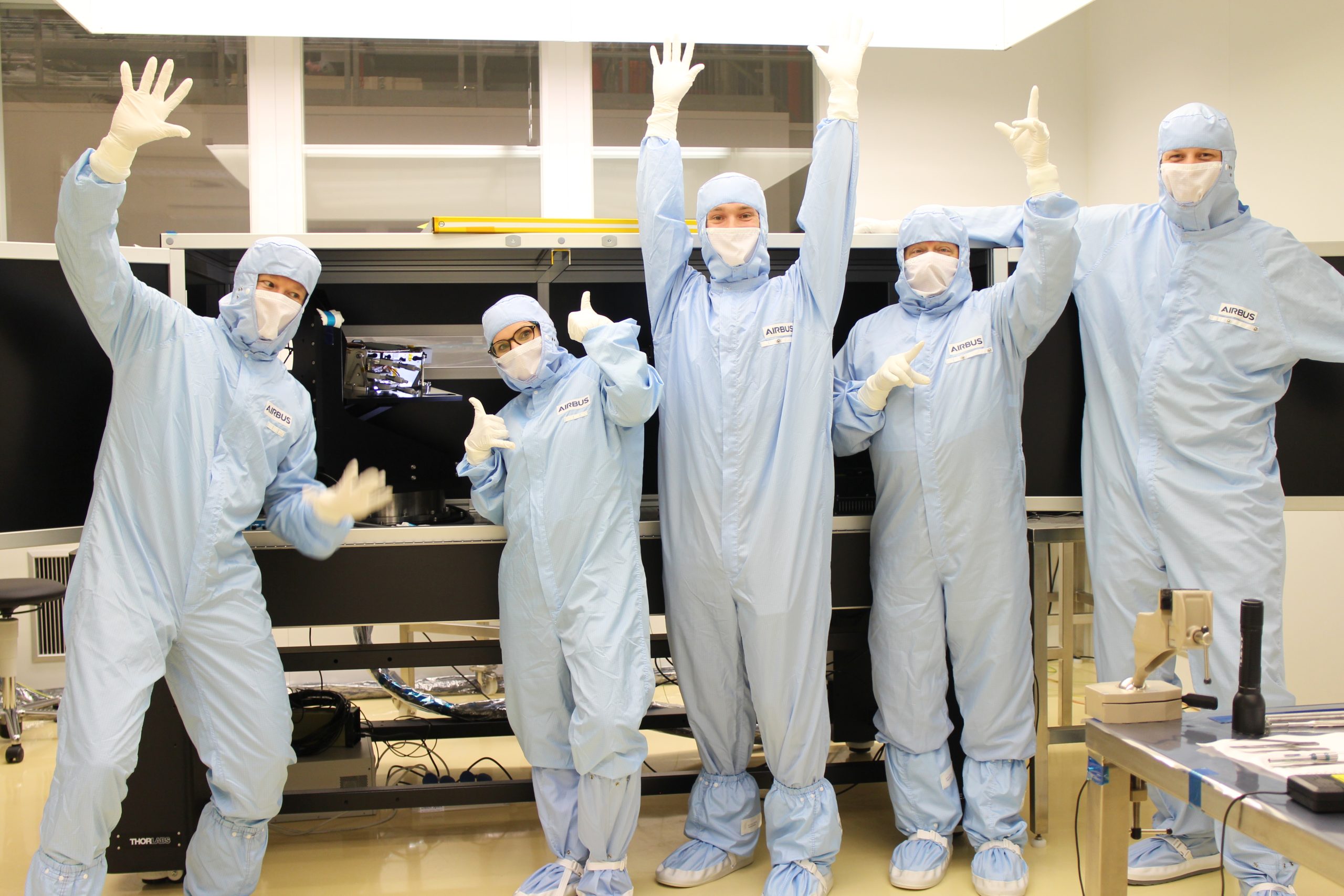SPEXone, het Nederlandse instrument aan boord van NASA’s PACE ruimtemissie, heeft haar ‘First Spectrum’ mijlpaal bereikt. Airbus Defence and Space Netherlands en SRON Netherlands Institute for Space Research ontwikkelen SPEXone om de gegevens te leveren voor aerosolanalyse in de aardatmosfeer.

SPEXone’s meest recente mijlpaal was ‘First Light‘, die liet zien dat de telescopen correct zijn gefabriceerd en uitgelijnd. Nu heeft het instrument haar ‘First Spectrum’ mijlpaal bereikt, wat betekent dat het volledige optische systeem, inclusief spectrometer, naar behoren werkt. Wanneer SPEXone vanaf 2023 aan boord van de PACE-satelliet door de ruimte vliegt, moet hij het spectrum meten van het door de Aarde weerkaatste zonlicht, om de soorten en hoeveelheden aerosolen te bepalen in de atmosfeer.
Ondanks de lastige omstandigheden in de Coronacrisis heeft het SPEXone-team de integratie van het instrument weten te voltooien. In de afgelopen weken is het team begonnen met uitlijnen. Dat is belangrijk omdat alle spectra precies goed op de detector moeten vallen—loodrecht en zonder vervorming—met behoud van optische kwaliteit. De eerste uitlijnmetingen worden gebruikt om de juiste positie van de detector te bepalen. Daarna zal de detector zijn vaste plek krijgen in de behuizing van het instrument.
In de praktijk voeren de onderzoekers de testmetingen niet uit over het volledige spectrum, maar gebruiken ze lasers die een specifieke set golflengtes uitzenden. Die dienen als een zogenoemde ‘sterprikkel’—een lichtbron die slechts vanuit één richting licht uitzendt. ‘De eerste resultaten zijn erg bemoedigend,’ zegt instrumentwetenschapper Jeroen Rietjens. ‘De afbeeldingen zijn zelfs scherper dan verwacht.’ Dirk Slootweg, manager Assembly, Integration & Testing, voegt daaraan toe: ‘De integratie van een ruimte-instrument is altijd een uitdaging. Het team heeft zich, met alle beperkingen omtrent de Corona-uitbraak, uit de naad gewerkt om de integratie te voltooien en te kunnen beginnen met de eerste uitlijning.’
SPEXone is ook geslaagd voor de Pre-Environmental Review, wat betekent dat het team kan starten met de tests die de lancering en de ruimteomgeving nabootsen, vanaf eind juni.
SPEXone is een compact optisch instrument dat aerosolen gaat karakteriseren vanuit een lage baan om de Aarde. Het is onderdeel van de NASA PACE-missie (lancering in 2023), als een partnered payload. SPEXone wordt ontwikkeld door een samenwerking tussen SRON Netherlands Institute for Space Research en Airbus Defence and Space Netherlands. TNO biedt ondersteuning aan de optische aspecten van het ontwerp en het fabriceren van de vrije vormspiegels.
First Spectrum milestone for aerosol space instrument SPEXone
SPEXone, the Dutch instrument onboard NASA’s PACE mission, has reached its ‘First Spectrum’ milestone. Airbus Defence and Space Netherlands and SRON Netherlands Institute for Space Research develop SPEXone to provide the data for aerosol analysis in our atmosphere.

SPEXone’s most recent milestone was ‘First Light‘, demonstrating the correct manufacturing and alignment of the telescopes. Now the instrument reaches its ‘First Spectrum’ milestone, which means that the full optical system, including the spectrometer, performs as intended. When SPEXone flies onboard the PACE spacecraft from 2023 onwards, it will need to measure the spectrum of light reflected by the Earth in order to determine the amount and type of aerosols in the Earth atmosphere.
In spite of the difficult conditions brought about by the Corona crisis, the SPEXone team completed the integration of the instrument, and started the first alignment activities over the past few weeks. Alignment is important to make sure that all the spectra are correctly imaged on the detector, without skew or distortion, and with the required optical quality. The first alignment measurements will be used to determine the correct position of the detector. In a second step the detector will be permanently fixed to the instrument housing.
In practice, the test measurements are not done for the full spectrum, but with dedicated lasers that emit a set of particular wavelengths on all viewports by means of a so-called ‘star stimulus’, a light source that emits light from a single direction only. ‘The first results are very encouraging,’ says instrument scientist Jeroen Rietjens. ‘The images are even sharper than expected.’ Dirk Slootweg, manager Assembly, Integration & Testing, adds: ‘The integration of a space instrument is always challenging. To complete the integration and start the first alignment activities of SPEXone within the constraints of the corona outbreak, the team went above and beyond.’
SPEXone has also passed the Pre-Environmental Review, meaning that the team can go forward with tests simulating the launch and space environment, starting at the end of June.
SPEXone is a compact optical instrument to characterise aerosols in the Earth’s atmosphere from low Earth orbit. It is part of the NASA PACE mission (to be launched in 2023), as a partnered payload. SPEXone is developed in a partnership between SRON Netherlands Institute for Space Research and Airbus Defence and Space Netherlands. TNO provided support for optical aspects of the design, and the manufacturing of the free-form mirrors.


